
Stormwater Best Management Practices
This page includes information on both structural and non-structural practices that are commonly recommended to mitigate drainage and erosion concerns. These practices can be used by any property owner and support the City’s Eco-City Clean Waterways initiatives. The practices on this list include structural stormwater best management practices (BMPs) approved for use in meeting stormwater regulations (per the Virginia Stormwater BMP Clearinghouse website), as well as smaller-scale homeowner versions of these practices and stormwater-friendly landscaping activities. Structural BMPs on this list are considered green infrastructure BMPs that strive to replicate the natural water cycle and manage stormwater onsite near its source to reduce impact on water quality, flooding, and stream bank erosion.
Choosing a BMP for an Erosion or Drainage Problem
The "Soak It Up! Stormwater Solutions for Homeowners" webinar workshop hosted by the City and the Northern Virginia Regional Commission discusses the impacts of inadequate stormwater management, conventional solutions, and stormwater best management practice alternatives. The webinar describes what each BMP is; the function and application; and the benefits and limitations. The webinar is intended for homeowners who are considering implementing a BMP for an erosion or drainage problem rather than as a condition of development.
- Part I: Introduction (3 minutes)
- Part II: Conventional Solutions, Dry Well, Infiltration Trench, Swales (50 minutes)
- Part III: Conservation Landscaping, Rain Gardens, Permeable Pavers, Rain Barrels (50 minutes)
VCAP FUNDING
Property owners are encouraged to install BMPs on their property to address erosion and drainage issues. The City partners with the Northern Virginia Soil and Water Conservation District (NVSWCD) to administer the Virginia Conservation Assistance Program (VCAP) to provide technical assistance and grant funding – pending availability of funds – for applicable projects.
The VCAP Contractor List includes contractors who are familiar with stormwater BMPs and the Virginia Conservation Assistance Program, administered by the Northern Virginia Soil and Water Conservation District. Note that the City does not endorse any specific company. It is always recommended to ask contractors for a statement of their qualifications and follow up on their references, as well as getting at least three bids for any work to be done.
Stormwater-Friendly BMPs and Landscaping Practices
Rain Barrels

A rain barrel is a barrel-shaped container placed under your downspout to collect rainwater. You can then use it for watering plants, washing your car, and reducing your water bill. Rain barrels are a simple, efficient, low-cost method for homeowners to collect and recycle water. A rain barrel is a rainwater harvesting BMP when the water is reused.
Design & Installation
Guidance for voluntary installation by homeowners:
Standards for rainwater harvesting approved for use in meeting stormwater regulations:
- VA State Standards and Specifications No. 6
- Visit the Virginia BMP Clearinghouse website for more information, including the Cistern Design Excel Spreadsheet and Technical Memorandum
Inspection & Maintenance
Inspection and maintenance should be performed at least annually. Determination of whether a rain barrel is properly functioning would include certification of the following:
- The rain barrel is free of any structural damage - Check the outside of the rain barrel for dents, cracking, or other imperfect ions that can lead to leaks. Check on the condition of mosquito net s or screens for tears.
- The rain barrel is free of leaks - Check for signs of water leaking through the rain barrel. Water mark s or streaks may be evident.
- The screen is free of leaves and debris - While the screen is effective at keeping mesquites out, the screen may also prevent stormwater from entering the rain barrel if it is clogged.
- The gutter and downspout are free of debris - The gutter and downspout should be cleared of leaves and debris every spring and fall to keep water flowing to your rain barrel and protect your home from roof leaks and water damage.
- Stored water is regularly used - Water stored in t he rain barrel should be drained soon after a rain to leave capacity for t he next rain. Before the first winter freeze, disconnect and drain the rain barrel.
Resources
Credits for Annual Maintenance
Stormwater Utility Fee credits are available for residential townhome and single-family individual lots with rain barrels and for non-residential and residential condominium properties that use rain barrels as part of rainwater harvesting. Refer to the credit manual for more information.
- Residential self-certification form for SWU Flat Credits
- Certification form for all other Stormwater Utility Fee eligible rainwater harvesting practices
Cisterns
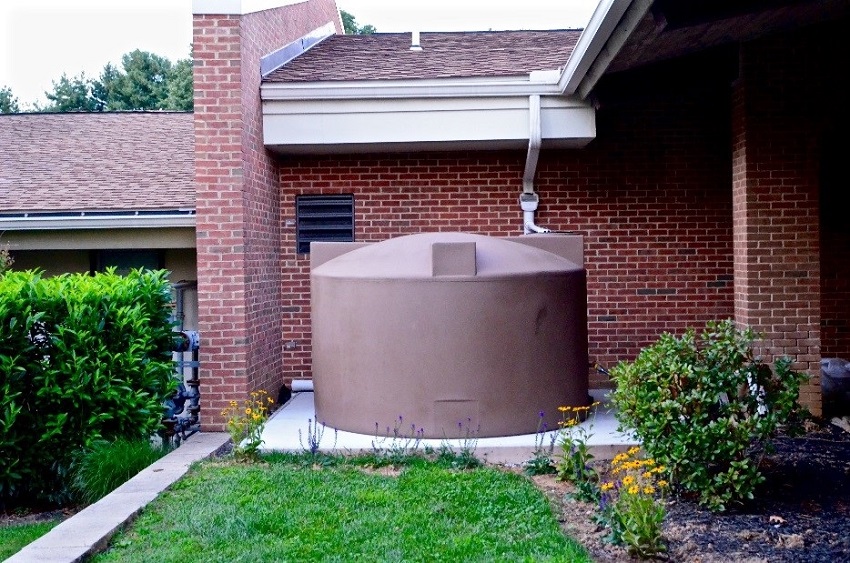
Cisterns are tanks used to catch rainwater running off roofs from a downspout. Cisterns are like large rain barrels. You can then save on your water bill by using the collected water for irrigation or other building uses if certain restrictions are met. A cistern is a rainwater harvesting BMP when the water is reused.
Design & Installation
Guidance for voluntary installation by homeowners:
- Cisterns may be purchased commercially.
- VCAP Contractor List includes contractors who are familiar with stormwater BMPs and the Virginia Conservation Assistance Program, administered by the Northern Virginia Soil and Water Conservation District. Note that the City does not endorse any specific company. It is always recommended to ask contractors for a statement of their qualifications and follow up on their references, as well as getting at least three bids for any work to be done.
Standards for rainwater harvesting approved for use in meeting stormwater regulations:
- VA State Standards and Specifications No. 6
- Visit the Virginia BMP Clearinghouse website for more information, including the Cistern Design Excel Spreadsheet and Technical Memorandum
Inspection & Maintenance
Inspection and maintenance should be performed at least annually. Determination of whether a cistern is properly functioning would include certification of the following:
- The cistern is clear of cracks and other damage - Check the outside of the c istern for dents, cracking, or other imperfections that can lead to water leaks.
- The cistern is free of leaks - Check for signs of water leaking. Water marks may be evident. Valves, fittings, and ot her hardware should be replaced as needed.
- The gutter and downspouts are free of leaves or other debris - The gutter and downspout s hould be cleared of leaves and debris every spring and fall to keep water flowing to your cistern and protect your home from roof leaks and water damage.
- Stored water is regularly used - Water stored in t he cistern should be drained soon after a rain to leave capacity for t he next rain. Before the first winter freeze, disconnect and drain the cistern.
Resources
- BMP Maintenance & Schedule Guidelines (Rainwater Harvesting)
Credits for Annual Maintenance
Stormwater Utility Fee credits are available for residential townhome and single-family individual lots with cisterns and for non-residential and residential condominium properties that use cisterns as part of rainwater harvesting. Refer to the credit manual for more information.
- Residential self-certification form for SWU Flat Credits
- Certification form for all other Stormwater Utility Fee eligible cisterns
Rain Gardens
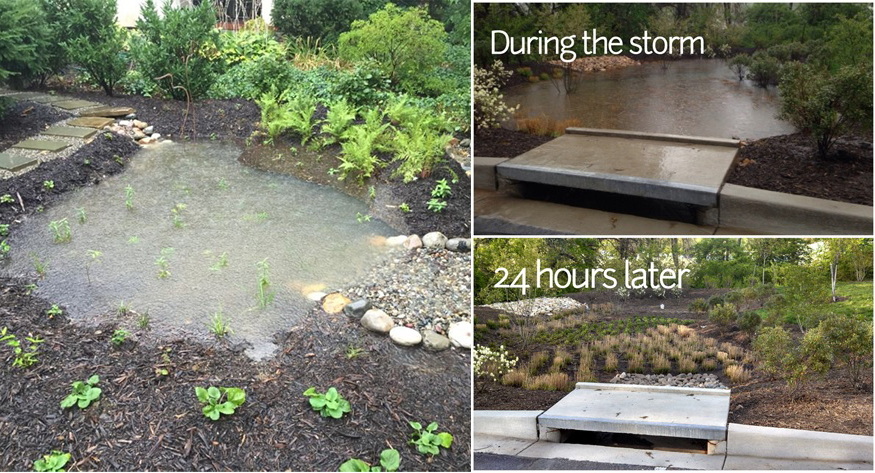
Rain gardens are considered micro-bioretention filters that are appropriate for single-family homes and townhouses. Like larger bioretention filters, rain gardens are bowl-shaped planted areas or swales where runoff can collect and be used by plants and/or soak into the ground. During storms, runoff typically ponds 6 to 12 inches above a surface mulch layer and then rapidly filters through a mixture of sand, soil, and organic material.
Often the ground below the rain garden is excavated and filled in with more permeable soil. Plants are selected to tolerate both flooding and drought. The photos below show a rain garden and a bioretention area that have been recently planted. As plants mature the gardens will look fuller.
In some rain gardens and in larger bioretention filters, an underdrain returns filtered stormwater to the storm drain system where infiltration rates are too low. Mosquito prevention is achieved when designed correctly so that the ponded water drains within 24-48 hours, which is shorter than needed for mosquito reproduction.
Design & Installation
Guidance for voluntary installation by homeowners:
Standards for bioretention approved for use in meeting stormwater regulations:
- VA State Standards and Specifications No. 9
- Bioretention Photo Tutorial to Accompany Bioretention Design Specification
Inspection & Maintenance
Inspection and maintenance should be performed at least annually. Determination of whether a rain garden is properly functioning would include certification of the following:
- Side slopes are free from observable erosion or tracking of sediment into the rain garden - Ensure that areas surrounding the rain garden are covered with plant growth 10 help slow the velocity or runoff and reduce erosion or sediment tracking and clogging In the rain garden.
- The rain garden Is free of leaves, debris, and sediment - Remove leaves, debris and accumulated sediment from the plant bed and Inlets. These may prevent stormwater from flowing through the mulch and into the planting media.
- Plants cover the planting bed consistently and uniformly (about 7S%-90% cover) - A consistent and uniform planting bed helps 10 dissipate Incoming stormwater, absorb stormwater, and reduce erosion or mulch In the planter box.
- The rain garden Is free of dead plants - Remove and replant dead plants. Refer to the Digital Atlas of the Virginia Flora Identify plants native to the region. Prune dead branches from trees and shrubs and deadhead perennials If needed to encourage blooming.
- The rain garden consists of native plant species and Is free of invasive plants - Native plants are adapted to local soils and climate conditions and help preserve natural ecosystems. Refer to the Digital Atlas or the Virginia Flora Identify plants native to the region.
- Mulch Is In an un-compacted state and between 2-3" thick - Mulch should be relatively loose and between 2 to 3 Inches thick . This allows stormwater runoff to flow Into the underlying soil media.
- Water that pools In the rain garden during rain events drains within 48 hours - Water may pond In the rain garden during rain events. This water should drain Into the mulch and soil media within the following 48 hours.
Resources
- Rain Garden Myths
- How to do a simple infiltration test
- Chesapeake Bay Landscape Professionals
- Finding Native Plants:
- More design guidance
- Alliance for Chesapeake Bay, Design Your Garden Online Tool
- Rain Garden Design and Construction: A Northern Virginia Homeowner’s Guide (NVSWCD 2009)
- Rain Gardens: A how-to manual for homeowners (WI DNR 2003)
- Rain Gardens Technical Guide (VA Department of Forestry, 2014)
- BMP Maintenance & Schedule Guidelines
Credits for Annual Maintenance
Stormwater Utility Fee credits are available for residential townhome and single-family individual lots with rain gardens and/or bioretention filters and for non-residential and residential condominium properties with bioretention filters. Refer to the credit manual for more information.
- Rain garden residential self-certification form for SWU Flat Credits
- Certification form for all other Stormwater Utility Fee eligible bioretention-practices
Flow Thru Planter Boxes

Flow thru planter boxes are considered above-ground rain gardens. Like rain gardens, they are micro-bioretention filters that are appropriate for single-family homes and townhouses. Like larger bioretention filters and rain gardens, flow thru planter boxes provide space where runoff can collect during storms.
Planter boxes receive water from downspouts and allow for water to pond 6 to 12 inches above a surface mulch layer. The water then rapidly filters through a mixture of sand, soil, and organic material. Mosquito prevention is achieved when designed correctly so that the ponded water drains within 24-48 hours, which is shorter than needed for mosquito reproduction. Some runoff is taken up by native plants. Plants are selected to tolerate both flooding and drought. Runoff that filters through the soil media in the planter box is discharged through an underdrain that typically returns filtered stormwater to the storm drain system.
Design & Installation
Standards for bioretention approved for use in meeting stormwater regulations:
- VA State Standards and Specifications No. 9
- Bioretention Photo Tutorial to Accompany Bioretention Design Specification
Inspection & Maintenance
Inspection and maintenance should be performed at least annually. Determination of whether a stormwater planter box is properly functioning would include certification of the following:
- The planter box is free of any structural damage - Check the planter box for cracks or buckling , tears in the liner, or signs of water damage.
- The planter box is free of leaks - Check the planter box walls for signs of water leaking. This can be evidenced by water streaks along the planter box wall.
- Water that pools in the planter box during rain events drains within 48 hours - Water may pond in the planter box during rain events. Th is water should drain into the mulch and soil media within 48 hours. Ensure there is space from the top of mulch to the planter box edge to allow ponding to occur.
- Plants cover the planting bed consistently and uniformly (about 75 % -90% cover) - A consistent and uniform planting cover will dissipate incoming runoff, absorb stormwater, and reduce erosion of mulch in the planter box.
- The planter bed is free of dead plants - Remove and replant dead plants. Refer to the Digital Atlas of the Virginia Flora identify plants native to the region. Prune dead branches from trees and shrubs and deadhead perennials if needed to encourage blooming.
- The planting bed consists of native plant species and is free from invasive plants - Native plants are adapted to local soils and climate conditions and help preserve natural ecosystems. Refer to the Digital Atlas of the Virginia Flora identify plants native to the region.
- The mulch is in an un-compacted state and is between 2-3" thick - Mulch should be relatively loose and between 2 to 3 inches t hick. This allows stormwater runoff to flow into the underlying soil media.
Resources
- Finding Native Plants:
- VCAP Contractor List includes contractors who are familiar with stormwater BMPs and the Virginia Conservation Assistance Program, administered by the Northern Virginia Soil and Water Conservation District. Note that the City does not endorse any specific company. It is always recommended to ask contractors for a statement of their qualifications and follow up on their references, as well as getting at least three bids for any work to be done.
- BMP Maintenance & Schedule Guidelines
Credits for Annual Maintenance
Stormwater Utility Fee credits are available for residential townhome and single-family individual lots with flow thru planter boxes and/or bioretention filters and for non-residential and residential condominium properties with bioretention filters, which may also consider planter box configurations. Refer to the credit manual for more information.
- residential self-certification form for SWU Flat Credits
- Certification form for all other Stormwater Utility Fee eligible bioretention-practices
Dry Wells
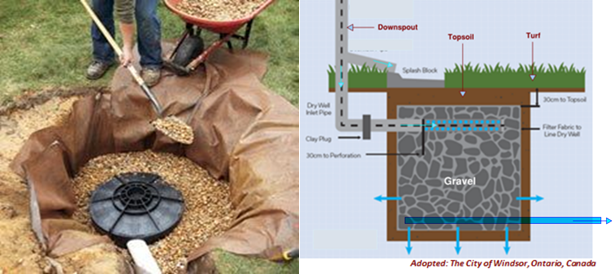
A dry well is considered a micro-scale infiltration practice per the Virginia BMP Clearinghouse. It temporarily stores runoff underground in the spaces between clean, washed, uniformly-sized stones until the water infiltrates into the soil. Dry wells can only be installed where a soil infiltration test is performed and only when the test indicates an acceptable infiltration rate. Overflow may be connected to a downspout with an overflow to a splash block or connection to the storm drain system. The design, pretreatment (for example: leaf gutter screens), and maintenance requirements vary depending on the area scale of the installation.
Design & Installation
Approved standards:
Inspection & Maintenance
Inspection and maintenance should be performed at least annually. Determination of whether a dry well or other infiltration practice is properly functioning would include certification of the following:
- The areas surrounding the dry well or infiltration practice are free from erosion or tracking of sediment into the practice - Areas surrounding the practice should be covered with plant growth. Cover bare areas with straw to help reduce sediment flow into the practice until plants are established.
- If connected to a rooftop downspout, the gutter and downspout are free of leaves or other debris - The gutter and downspout should be cleared of leaves and debris every spring and fall to keep water flowing to the practice and protec t your home from roof leaks and water damage.
- Surface of the practice and in lets are free of litter, leaves and sediment buildup - litter, leaves and sediment buildup in the practice can clog the stone and create a barrier for stormwater to flow through.
- Water that pools in the practice during rain events drains within 48 hours - Water may pond in the practice during rain events. This water should drain within the following 48 hours.
Resources
- How to do a simple infiltration test
- BMP Maintenance & Schedule Guidelines (Infiltration Practice)
Credits for Annual Maintenance
Stormwater Utility Fee credits are available for residential townhome, single-family, condominium and non-residential properties with an infiltration practice that was installed meeting the BMP Clearinghouse design specifications. Refer to the credit manual for more information.
- Residential self-certification form for SWU Flat Credits
- Certification form for all other Stormwater Utility Fee infiltration practices
Infiltration Trench

An infiltration trench is considered a small or conventional-scale infiltration practice per the Virginia BMP Clearinghouse. It is applicable for a variety of applications and for example, offers 1) greater volume of runoff infiltrated and treated on-site compared to a French drain and 2) an opportunity to reduce runoff or ponding in a yard area without losing usable space. Infiltration trenches treat runoff from nearly 100% impervious areas by temporarily storing the water underground in the spaces between clean, washed, uniformly-sized stones and allowing it to infiltrate into the soil. Infiltration trenches can only be installed where soil infiltration tests are performed and only when the tests indicate an acceptable infiltration rate. Multiple pretreatment techniques are required.
Design & Installation
Approved standards:
Inspection & Maintenance
Inspection and maintenance should be performed at least annually. Determination of whether a dry well or other infiltration practice is properly functioning would include certification of the following:
- The areas surrounding the dry well or infiltration practice are free from erosion or tracking of sediment into the practice - Areas surrounding the practice should be covered with plant growth. Cover bare areas with straw to help reduce sediment flow into the practice until plants are established.
- If connected to a rooftop downspout, the gutter and downspout are free of leaves or other debris - The gutter and downspout should be cleared of leaves and debris every spring and fall to keep water flowing to the practice and protec t your home from roof leaks and water damage.
- Surface of the practice and in lets are free of litter, leaves and sediment buildup - litter, leaves and sediment buildup in the practice can clog the stone and create a barrier for stormwater to flow through.
- Water that pools in the practice during rain events drains within 48 hours - Water may pond in the practice during rain events. This water should drain within the following 48 hours.
Resources
- How to do a simple infiltration test
- BMP Maintenance & Schedule Guidelines (Infiltration Practice)
Credits for Annual Maintenance
Stormwater Utility Fee credits are available for residential townhome, single-family, condominium and non-residential properties with an infiltration practice that was installed meeting the BMP Clearinghouse design specifications. Refer to the credit manual for more information.
- Residential self-certification form for SWU Flat Credits
- Certification form for all other Stormwater Utility Fee infiltration practices
Permeable Pavement
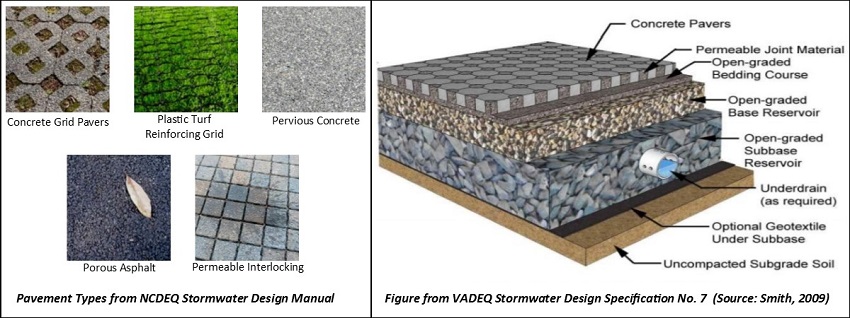
Permeable pavement incorporates three elements: 1) a pervious surface option, (i.e., permeable pavers, pervious concrete, porous asphalt, or cellular grid pavers), 2) a stone reservoir, and 3) an underdrain.
Design & Installation
Approved standards:
Inspection & Maintenance
Inspection and maintenance should be performed at least annually. Determination of whether a permeable pavement is properly functioning would include certification of the following:
- The permeable pavement system contains a permeable surface, gravel reservoir layer and an underdraln - Permeable pavement surfaces are porous concrete, asphalt, or pavers with gravel in the voids. The reservoir layer should consist of washed stone aggregate.
- The pavement surface edges are free of erosion and sediment accumulation from surrounding areas - Areas surrounding the practice should be covered with plant growth. Cover bare areas with straw to help reduce sediment flow into the practice until plants are established.
- Permeable pores or voids between pavers are free of litter, debris, and sediment - Periodically sweep the pavement and perform vacuum sweeping at least once a year as sediment and debris can clog the system. Shovel immediately after each snow, rather than using sand, salt or other fine particles.
- The permeable pavement does not pond or let water run off during a rain event - Permeable pavement should allow water to seep through the surface and into the reservoir layer beneath. Fill a 5 gallon bucket full of water, then pour it entirely on one spot of the permeable pavement. The water should seep into the permeable pavement, rather than pond on top of the surface or run off.
- The permeable pavement surface is free of cracks, heaving, or other structural damage - Check the pavement surface for cracks in the asphalt, concrete or pavers. Pavers may also heave, at which point they should be removed and reset.
Resources
- How to do a simple infiltration test
- BMP Schedule & Maintenance Guidelines
- ASTMc1701 Permeable Pavement Test & simple “ bucket test”
Credits for Annual Maintenance
Stormwater Utility Fee credits are available for residential townhome and single-family individual lots with permeable pavement systems that have a clean, washed gravel reservoir, as well as for non-residential and residential condominium properties with permeable pavement systems meeting state standards. Note that the Environmental Management Ordinance requires the installation of permeable surfaced driveways in some instances, which do not have a gravel reservoir and are therefore not eligible for stormwater utility fee credits. Refer to the credit manual for more information.
- Residential self-certification form for SWU Flat Credits
- Certification form for all other Stormwater Utility Fee eligible pavements
Green Roofs
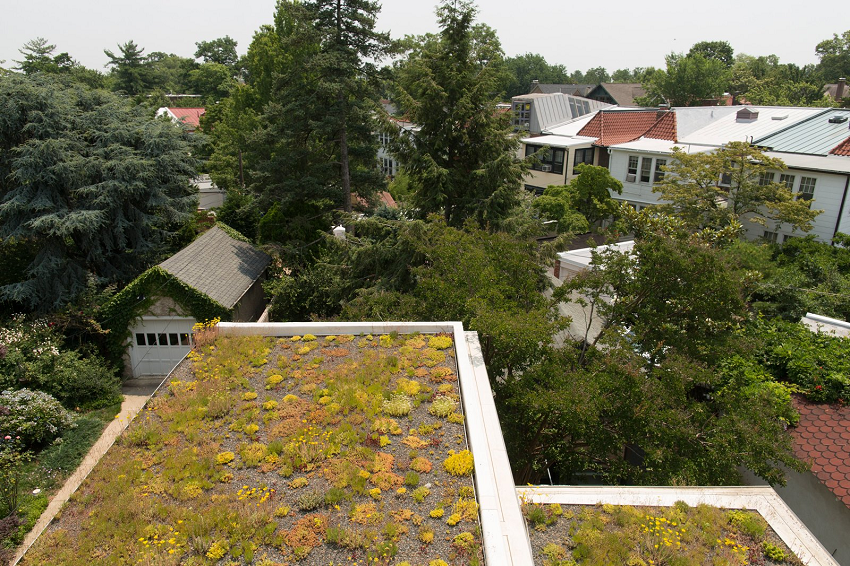
Vegetated green roofs typically consist of water proofing, drainage materials, an engineered growth media (soil) that is designed to support plant growth, and plants.
Design & Installation
Standards approved for use in meeting stormwater regulations:
Inspection & Maintenance
Inspection and maintenance should be performed at least annually. Determination of whether a vegetated green roof is properly functioning would include certification of the following:
- The waterproof membrane is free from leaks or cracks - Contact your green roof installer as soon as you see any signs of leaking or structural damage. Avoid using herbicides, insecticides, and fungicides as these can accelerate degradation of the waterproof membrane.
- The planting bed is free of dead plants - Remove and replant dead plants.
- The planting bed has adequate plant cover and is free from invasive plants - Plant cover shall be comprised of plant species according to the approved design; however, invasive plants should be replaced.
- The green roof is free from litter and debris - litter and debris buildup on the green roof can clog soil media and create a barrier for stormwater to absorb into the green roof. Clear inlets, outlets, gutters and downspouts.
- Manufacturer's recommendations for maintenance have been followed - Refer to the applicable manufacturer's documentation.
Resources
Credits for Annual Maintenance
Stormwater Utility Fee credits are available for residential townhome and single-family individual lots with green roofs, as well as for non-residential and residential condominium properties. Refer to the credit manual for more information.
- Residential self-certification form for SWU Flat Credits
- Certification form for all other Stormwater Utility Fee eligible green roofs
Urban Nutrient Management Plans
Urban Nutrient Management Plans provide a blueprint for proper use of fertilizers, ensuring that excess fertilizers and nutrients – which can harm water quality – are not readily available for transport to the City’s waterways via stormwater runoff. An urban nutrient management plan is a plan to manage the amount, placement, timing and application of fertilizer, compost, or other materials containing plant nutrients to reduce nutrient loss to the environment and to produce quality turf and landscape plants. Urban Nutrient Management plans must be prepared by a prepared by a Nutrient Management Planner Certified in Turf and Landscape by the Virginia Department of Conservation and Recreation (DCR).
Resources
- List of Certified Turf & Landscape Nutrient Management Planners familiar with the City's Stormwater Credit Policies.
- Virginia DCR’s Urban Nutrient Management website
Credits for Urban Nutrient Management Plans
Stormwater Utility Fee credits are available for residential condominium properties. Refer to the credit manual for more information.
Nutrient Management for All Properties
Properties who are not eligible for credit can still benefit by testing their soil before applying fertilizer. To find out more, visit:
- Soil sampling for the home gardener
- Virginia Tech Soil Test Lab Fees and Forms
Conservation Landscaping
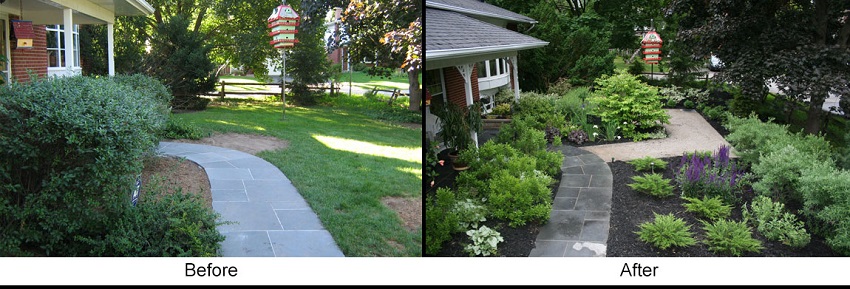
Conservation landscaping can be used to reduce polluted runoff by replacing areas of lawn or bare soil in your yard with native plants. Native plants are best suited to minimize runoff and require less nutrient addition or cultivation, reducing nutrient pollution. Conservation landscaping could also include establishing meadow or forested buffers or vegetated filter strips that intercept runoff and protect waterways.
Design & Installation
- The Eight Essential Elements of Conservation Landscaping - Chesapeake Conservation Landscaping Council
- Design Your Garden Online Tool - Alliance for Chesapeake Bay
Conservation landscaping can be designed to promote co-benefits like providing wildlife habitat and promoting pollinator health.
Inspection & Maintenance
Inspection and maintenance should be performed at least annually. Determination of whether a conservation landscaping practice is properly functioning would include certification of the following:
- The conservation landscape Is free of dead plants - Remove and replant dead plants. Refer to the Digital Atlas of the Virginia Flora identify plants native to the region. Prune dead branches from trees and shrubs and deadhead perennials If needed to encourage blooming.
- The conservation landscape consists of native plant species and is free of invasive plants - Native plants are adapted to local soils and climate conditions and help preserve natural ecosystems. Refer to the Digital Atlas of the Virginia Flora Identify plants native to the region.
- The plant bed is free of litter, leaves or other debris buildup - Litter, leaves and debris In the conservation landscape can Impede or otherwise harm plant growth In the conservation landscape.
Resources
- Chesapeake Bay Landscape Professionals
- Finding Native Plants:
- Green Landscaping For You and the Chesapeake Bay May 2011 presentation slides This resource includes the presentation slides from one of a series of Green Building Workshops offered by the City in 2011. It provides great photos of conservation landscaping and rain gardens for single-family and townhouse owners who may be interested in these practices, as well as photos of native vs non-native plants.
Credits for Annual Maintenance
Stormwater Utility Fee credits are available for conservation landscaping practices on residential townhouse and single-family individual lots. Refer to the credit manual for more information.
- Residential self-certification form for SWU Flat Credits
New Native Tree Planting
Tree planting mitigates the stormwater quality impact of impervious and turf land covers in urban areas. Native trees support native pollinators and wildlife, in particular by providing habitat for caterpillars and food for baby birds. Some native trees are better at this than others, especially native oaks and native cherry trees. Plus, shade trees help contribute to meeting the City's canopy coverage goals.